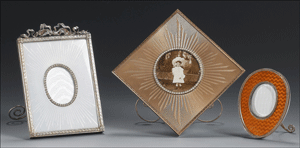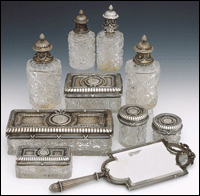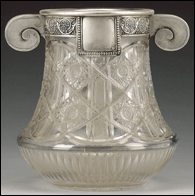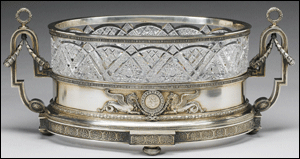|
From Russia With Love: Collecting Fabergé
By Daniele Gair
There is something about royal treasure that piques the imagination. The English Crown Jewels in London enjoy a steady stream of admirers. The contents of the tomb of King Tut, including the mummified pharaoh himself, went on one of the most successful museum tours of all time in the 1970s. But if anything speaks of the opulence and luxury enjoyed by the most privileged classes, it is the work of the House of Fabergé. In fact, the thought of owning one of the 50 Imperial eggs created by the enigmatic jeweler for the wives of Russian Czars Alexander III and Nicholas II can make any collector wistful. Though the eggs were Fabergé’s calling card, they were only a fraction of the beautiful and innovative items that emerged from these storied workshops.
|

|
A Fabergé gold-and-enamel photograph
frame by Henrik Wigström; St. Petersburg,
1899-1908.
|
With a name that literally translates to “maker,” Fabergé’s destiny seems to have been set from birth. Born in St. Petersburg in 1846 to Gustav Fabergé, a modest jeweler of French Huguenot ancestry, Carl Gustav Fabergé joined his father’s business around 1860. By the time he was 24, he had taken over control of all aspects of the business. Like many of these firms, Fabergé sold items to the Imperial Court of Russia; however, the younger Fabergé soon set the family business apart. Gradually, Fabergé emerged as the most fashionable jeweler in Russia, thanks to a fateful commission in 1885.
Easter is the major holiday in the Eastern orthodox religion, and in Russia, the holiday is celebrated with particular fervor. In 1885, Czar Alexander II commissioned a special Easter gift for his empress, Maria Feodorovna, from Fabergé’s workshops, an egg crafted of gold-and-white enamel. This egg, which contained several surprises, is considered to be the first of about 50 created for Czar Alexander and later, for his son, Czar Nicholas II, who commissioned eggs for his mother and for his bride, Alexandra. Each completely unique, most of the eggs are now housed in museums and private collections all over the world. Eight of the eggs are still missing, but hope still remains that they may yet be found.
|

|

|
|
A Fabergé silver-mounted, cut-glass,
ten-piece dressing set by workmaster
Anders Nevalainen, St. Petersburg,
late 19th Century.
|
A late 19th Century Russian
silver-mounted and cut-glass,
two-handled vase, ca. 1890.
|
Fabergé produced thousands of items, including jewelry, compacts, hardstone figures-and-flower sculptures, and silver flatware services. While the Imperial eggs were the unquestioned showpieces, these other items were crafted as the moneymakers of Fabergé’s business. For example, a large silver centerpiece could be sold for as much as 50,000 rubles. Today, these items are considered to be well within the reach of private collectors.
After the Revolution, both those fortunate patrons who were able to escape to the West and those who stayed were forced to try and sell their Faberge pieces in order to live. Since the taste for such extravagant items had waned with the advent of Art Deco, many items, some one-of-a-kind, were destroyed and sold for the value of their jewels or metals. However, many more items were preserved by collectors such as Armand Hammer, Marjorie Merriwether Post and Matilda Geddings Gray. Many pieces, such as the famed Malcolm Forbes collection of nine Imperial eggs purchased by Russian billionaire Viktor Vekselberg, have now returned to Russia.
|

|
A large Faberge silver-mounted, cut-glass centerpiece; Moscow, 1908-1917.
|
Collecting Fabergé today requires a bit of savvy, as there are tax, security and insurance concerns to be dealt with. Many collectors choose to work with art dealers, who represent their clients at auction. Fortunately, Fabergé items do come to auction quite frequently. Some of the most desirable pieces include household items, such as a silver-mounted and cut-glass two-handled vase, circa 1890, which was auctioned by Bonham’s for £21,600 in 2005, or the large, silver-mounted, cut-glass centerpiece, created in the Moscow workshop circa 1908-1917, which was auctioned by Bonham’s in 2006 for £128,800. Smaller, more personal items are also popular and available, such as a silver, gilt-and-pink enamel cigarette case that was auctioned by Sotheby’s for £9,988 in 2002. Also popular are hardstone figures and enamels.
|

|
|
Various Fabergé marks.
|
Among the first things to look for when considering an item for purchase is the mark. Silver and gold items are usually marked with a maker’s mark, assay mark and standard marks, verifying that the object is made of precious metals. Fabergé items feature the name “FABERGE” in Cyrillic letters as well as zolotnik standard marks. Zolotniks correspond to carats. For gold, 56, 72 and 96 zolotniks are equal to 14, 18 and 24 carats. Silver alloys are found in 84, 88, 91 and 96 zolotniks, or 875, 916, and 947/1000 parts, and pure silver.
Also, look at the quality of the piece. Fabergé used only the finest metals and stones, and he revolutionized the art of enameling. Any authentic piece should reflect that. Do your research about what sets Fabergé apart from the many imitators, from the magnificent depth and range of colors achieved, to the exceptional craftsmanship, naturalistic sensibility and unmatched intricacy.
_______
Resources: Fabergé: Imperial Jeweler by Géza von Habsburg and Marina Lopato; Masterpieces from the House of Fabergé by Alexander von Solodkoff, ed.; Fabergé and the Russian Master Goldsmiths by Gerard Hill, G.G. Smorodinova and B. L. Ulyanova. Fabergé mark images courtesy of Giorgio B.
/www.silvercollection.it. All other images are courtesy of Bonham’s London.
___________________________________
A native New Orleanian, Daniele Gair has been obsessed with the written word and the arts ever since she could remember. Holding a B.A. in English from Newcomb College of Tulane University, she has honed her skills as a professional writer for 14 years. Daniele has explored the world of visual art as an owner of an art gallery/snowball stand, and she currently researches and writes about fine art and antiques for M.S. Rau Antiques in New Orleans.
|